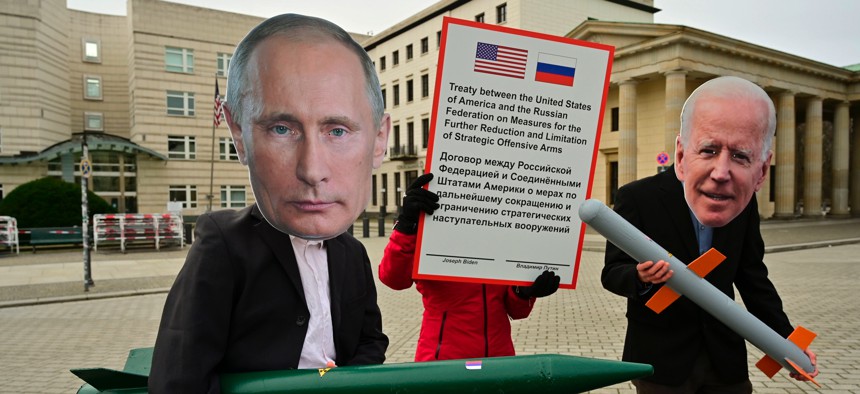
Peace activists wearing masks of Russian President Vladimir Putin and U.S. President Joe Biden pose with mock nuclear missiles in front of the U.S. embassy in Berlin on Jan. 29, 2021. JOHN MACDOUGALL/AFP via Getty Images
Trying to Box in Biden on Arms Control
Former Trump officials complain that the new president doesn’t want what they failed to achieve.
On Joe Biden’s first full day in the Oval Office, the White House announced its readiness to extend the New Strategic Arms Reduction Treaty, or New START, for five years. Former Trump administration officials wasted no time attacking the decision, asserting—falsely—that their work had provided a basis for achieving something more substantial with the Russians.
These former officials are criticizing the Biden team for failing to aim for what they could not get during four years in office. They seek to set their failed negotiating aspirations as a bar against which to judge and disparage their successors’ work.
New START, which entered into force in 2010, reduced U.S. and Russian strategic nuclear forces to levels not seen since the 1960s. The treaty is set to expire on Feb. 5, though its provisions allow it to be extended for up to five years. The Biden administration thus had to move quickly to preserve the treaty’s security benefits for the United States and its allies.
Trump administration officials ignored the extension question for more than three years. When they finally engaged with their Russian counterparts on New START’s fate, they put forward a series of demands, apparently believing that Moscow’s desire to extend the treaty gave them negotiating leverage.
Events proved them wrong.
In a May 2020 interview, Marshall Billingslea, Trump’s chief arms control negotiator, laid out three conditions for U.S. assent to extend New START: inclusion of China in the arms control process, Russian agreement to negotiate on non-strategic nuclear arms, and correcting alleged weaknesses in New START’s verification regime.
Bringing China into the arms control process and getting Russia to negotiate on all nuclear weapons—not just strategic ones—are laudable goals, but this was not the way to achieve them. By contrast, criticisms of New START’s verification regime were spurious; for the past ten years, U.S. military and intelligence officials have been able to confirm Russia’s compliance.
In any case, Trump’s negotiators went zero for three.
Beijing adamantly refused to enter nuclear arms talks, while Russian officials made clear they would not press the Chinese. Moscow refused to commit to negotiate on non-strategic weapons and, unsurprisingly, showed no readiness to fix nonexistent shortcomings in New START’s monitoring provisions.
Over the succeeding months, these conditions fell by the wayside. By mid-October, with two weeks remaining before the presidential election and Trump apparently eager for agreement, his administration’s conditions for extension had been reduced to one: a verified one-year freeze on the overall size of the U.S. and Russian nuclear warhead stockpiles.
At this point, Moscow made a modest concession. The Ministry of Foreign Affairs stated that Russia would agree to a one-year freeze but “strictly and exclusively if there is understanding that the ‘freezing’ of warheads will not be accompanied by any additional demands”—that is, no verification provisions and no commitment to negotiations towards a longer-term agreement. With no way to bridge this gap—over verification, in particular—negotiations ceased.
Almost immediately, Billingslea tried to put his failure to use. Aiming to box in the not-yet-elected Biden administration, he claimed that the nonexistent agreement “now sets the floor for future arms control discussions.” So it’s hardly surprising that he now says an agreement was in reach. He tweeted on January 21 that the Biden administration should have held out for “a short six-month extension conditioned on finalizing the warhead cap [freeze]”—presumably putting in place a verification regime. What part of “nyet” did he not understand?
There is no capping agreement to finalize. Moreover, even if the Russians were willing to talk verification, agreeing on and putting in place the appropriate measures to monitor a warhead freeze would almost certainly take longer than six months, likely much longer.
Having failed themselves, former officials now seek to denigrate the Biden administration’s efforts from the onset. Another claimed: “The Russians are going to take a five-year extension, they are going to pocket it, and then they'll say, ‘see you in 2026, Americans.’”
This criticism appears to be a shameless effort to whitewash the Trump administration’s sad nuclear arms control legacy. Trump left office as the first American president in 50 years not to have produced a single agreement in this area.
Meanwhile, New START’s extension — the Kremlin announced Friday that Putin had signed off on it — will mean that Russian strategic nuclear forces remain constrained until 2026, and the United States will continue to receive information about those forces from the treaty’s data exchanges, notifications and on-site inspections. And the United States gets those benefits without having to make any changes in its strategic modernization plans, which were designed to fit within New START’s constraints.
Not a bad beginning for Biden’s arms control policy.
Steven Pifer is a fellow at the Robert Bosch Academy. James Acton is co-director of the Nuclear Policy Program at the Carnegie Endowment for International Peace. These views are their own.
NEXT STORY: The Next Steps For the Pentagon's AI Hub



